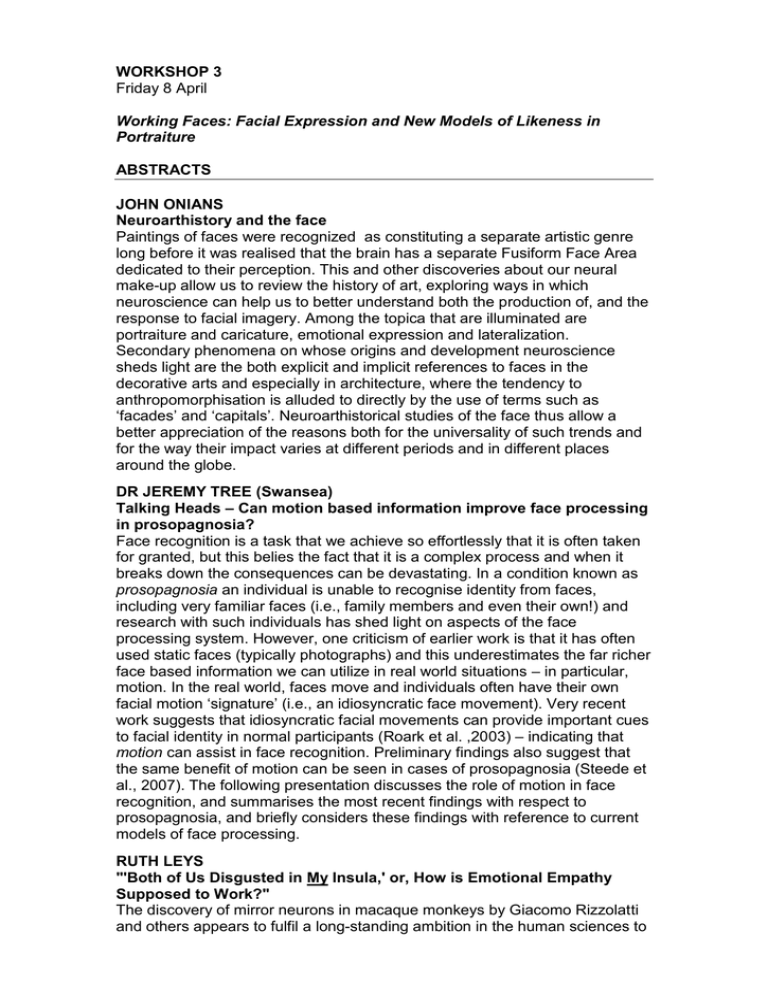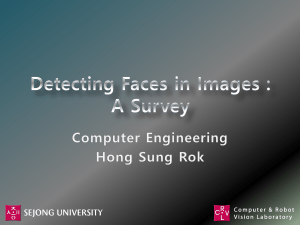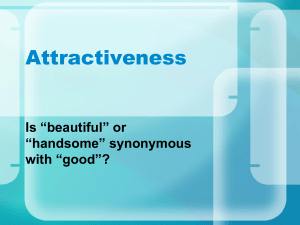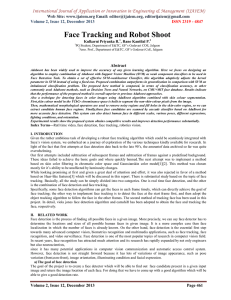WORKSHOP 3 ABSTRACTS JOHN ONIANS Neuroarthistory and the face
advertisement

WORKSHOP 3 Friday 8 April Working Faces: Facial Expression and New Models of Likeness in Portraiture ABSTRACTS JOHN ONIANS Neuroarthistory and the face Paintings of faces were recognized as constituting a separate artistic genre long before it was realised that the brain has a separate Fusiform Face Area dedicated to their perception. This and other discoveries about our neural make-up allow us to review the history of art, exploring ways in which neuroscience can help us to better understand both the production of, and the response to facial imagery. Among the topica that are illuminated are portraiture and caricature, emotional expression and lateralization. Secondary phenomena on whose origins and development neuroscience sheds light are the both explicit and implicit references to faces in the decorative arts and especially in architecture, where the tendency to anthropomorphisation is alluded to directly by the use of terms such as ‘facades’ and ‘capitals’. Neuroarthistorical studies of the face thus allow a better appreciation of the reasons both for the universality of such trends and for the way their impact varies at different periods and in different places around the globe. DR JEREMY TREE (Swansea) Talking Heads – Can motion based information improve face processing in prosopagnosia? Face recognition is a task that we achieve so effortlessly that it is often taken for granted, but this belies the fact that it is a complex process and when it breaks down the consequences can be devastating. In a condition known as prosopagnosia an individual is unable to recognise identity from faces, including very familiar faces (i.e., family members and even their own!) and research with such individuals has shed light on aspects of the face processing system. However, one criticism of earlier work is that it has often used static faces (typically photographs) and this underestimates the far richer face based information we can utilize in real world situations – in particular, motion. In the real world, faces move and individuals often have their own facial motion ‘signature’ (i.e., an idiosyncratic face movement). Very recent work suggests that idiosyncratic facial movements can provide important cues to facial identity in normal participants (Roark et al. ,2003) – indicating that motion can assist in face recognition. Preliminary findings also suggest that the same benefit of motion can be seen in cases of prosopagnosia (Steede et al., 2007). The following presentation discusses the role of motion in face recognition, and summarises the most recent findings with respect to prosopagnosia, and briefly considers these findings with reference to current models of face processing. RUTH LEYS "'Both of Us Disgusted in My Insula,' or, How is Emotional Empathy Supposed to Work?" The discovery of mirror neurons in macaque monkeys by Giacomo Rizzolatti and others appears to fulfil a long-standing ambition in the human sciences to understand aspects of human and animal behaviour as forms of motor mimicry according to which the subject automatically echoes, or empathizes with, the behaviour of others because of a shared mirror neuron mechanism. In my presentation, I will discuss attempts to extend the mirror neuron hypothesis to emotional behaviour. In an experiment carried out by Rizzolatti and others, subjects were tested for their empathic responses to facial expressions of disgust as measured by brain activation. The aim of the experiment was to challenge the primacy of cognition in emotions by emphasizing the ways in which spectators precognitively grasp the emotions of others because of the determining role of neural simulation. In the course of my paper, I will question the plausibility of such a mirror neuron explanation of the disgust response. ALAN JOHNSTON (UCL) Dynamic Faces The vast majority of work on human face perception has studied the frozen facial image, a frame sampled from the dynamic procession of one transient expression to another. To some degree this has been a necessary simplification, both technically and theoretically, to allow progress in the understanding of how we see faces and in discovering the neural structures on which this process is based. In recent years it has become easier to generate, manipulate, control and display moving faces and so progress in understanding dynamic facial perception is gathering speed. However, the past emphasis on static faces may have obscured a key role for movement in forming the mechanisms of encoding not only moving faces but facial structure in general. In redress, here we explore the central role of change in the representation of faces. MANDY MERCK Recognition and celebrity Philosophers remind us that the term ‘recognition’ has many meanings. In The Struggle for Recognition (1995) Axel Honneth distinguishes recognition by one’s family and close friends (‘love’) from that within the legally regulated field of rights (‘respect’) and that of the social world of work (‘esteem’). Paul Ricoeur opens The Course of Recognition (2005) with an extensive investigation of the ‘rule-governed polysemy’ in the philosophical use of the term, distinguishing recognition as identification of people or objects from recognition as validation of a claim, recognition as gratitude for a gift or favour, and recognition as the acceptance of someone as a leader. Ricoeur is most interested in the combination of separateness and mutuality that characterizes the relations of love and friendship. But en route he cites Luc Boltanski and Laurent Thevenot on the ‘economies of standing’ in which we compete for the form of recognition known as ‘renown’. Andy Warhol (who knew a thing or two about the economics of renown) famously contracted its commercial cycle to fifteen minutes. Although he is best known for his hieratic silk screens of mega-celebrities like Elvis, Marilyn and Mao, I want to go back to his reversal of recognition in his early 60s representations of little or unknown figures, such as his ‘Thirteen Most Wanted Men’, whose enlarged New York Police mugshots he painted on the façade of Philip Johnson’s state pavilion at the 1964 World Fair. (These men’s monumental exhibition itself survived only for a few days, until Governor Rockefeller ordered the mural painted over.) The predecessor to this censorable public registration of notoriety as desirability was its gay registration in Warhol’s first Screen Tests, for a projected series titled ‘The Thirteen Most Beautiful Boys’. It is the Screen Tests that I will discuss, in terms of the recognisability – and defamiliarization – of Warhol’s more and less famous subjects. NATHALIE HERSCHDORFER Making Faces: The New Photographic Portrait Today many artists question the portrait, which is traditionally seen as the reflection of the personality or a window open on the soul. We live in a time where the nature of face has changed. For a long time, Western culture conceived the face as a destiny. A face was fixed, static and had universal expressions: humans had one single face from birth to death. Today this belief has eroded: retouching and plastic surgery are no longer exceptional practices. Not only the way we look at faces has changed, but also the way we look at and make photographs. Nowadays, virtually anyone can wield the photographic tools, quickly and with a minimum of instruction – a ‘photoshop’ in every home! We retouch our images, because we want to see “a better reality”, a reality which seems more attractive to the gaze. Images are seen as variants, different possibilities, not something definitive. Today, photographers no longer believe that we know a person from the image of his/her face. Questioning identity is a major topic in contemporary photography: artists are constructing and exploring a new genre, what might be called the « antiportrait ». Digital technology has changed the appearance of photographic portraits. They seem more stylized. Artists represent people who somehow look real and artificial at the same time, striking a balance between the reality of the flesh and the ideals of beauty. Studying the portrait as a photographic genre makes us aware of how representations can be different in time and depend on the culture in which they are produced. Representations change because we never represent someone for what he is but according to the idea we have of the person. Photography belongs to a cultural process, it betrays a specific time, a specific society or culture. It raises questions, reflects certainties, uncertainties, the dreams and torments of its society. The portrait is dead, but the face is alive. PAUL WHITE Darwinian expression and the face of physiology Darwin's work on the emotions is often viewed as a watershed in the history of facial expression, challenging the theological assumptions that underpinned Lavaterian physiognomy, and furnishing a 'real' geneaological connection between human and animal likeness. Yet there is another, perhaps more unsettling feature of Darwin's work, namely the severing of inner character from outward appearance. Drawing on new developments in physiological theory and practice, Darwin redefined the nature of expression as a set of instinctual, reflex responses that took place beneath the surface of the skin. Widely regarded by Darwin's predecessors as a medium of sympathy and window to the soul, the face became a deceptive device, proving that the play of mind and body was no more than a stage-set concealing a mechanism.









